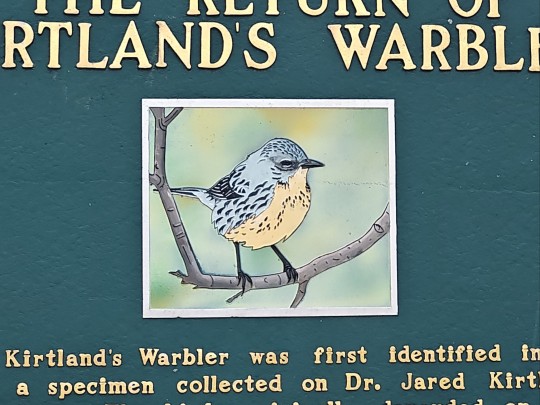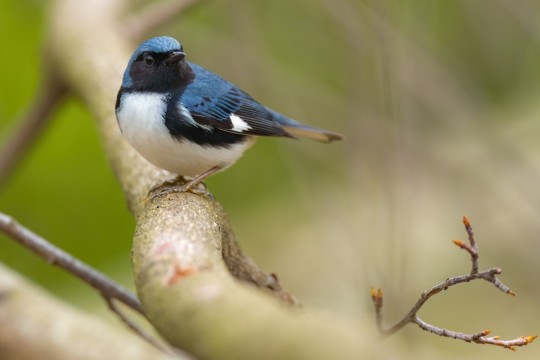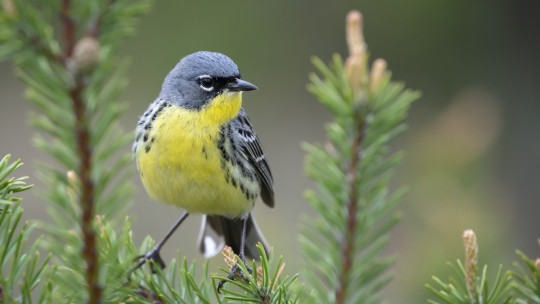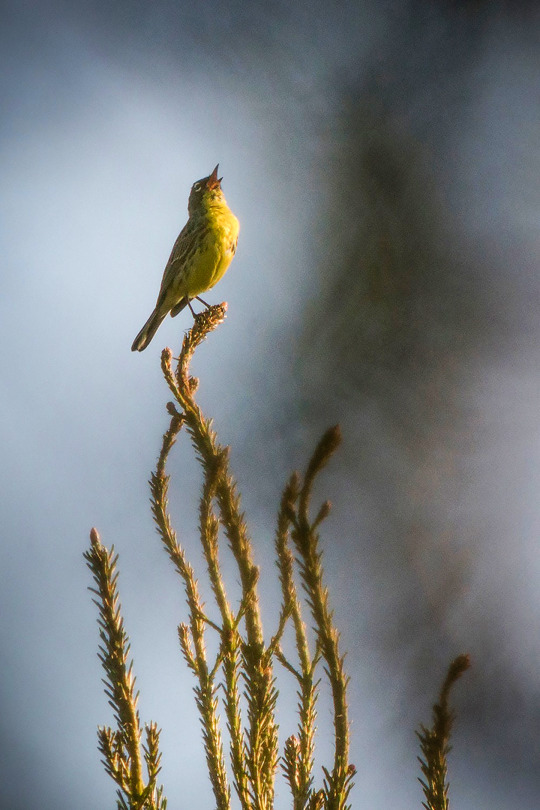#kirtland's warbler
Explore tagged Tumblr posts
Text
It's always good news when a rare native species rebounds from the brink of extinction. The Kirtland's warbler was once down to about two hundred individuals, but with conservation efforts the population is almost to five thousand. This is still a very small number, but it's a heartening change.
The warbler was removed from the U.S. Endangered Species List in 2019. While this may seem like a good thing, it means these birds have lost some of the legal protection that earned them breathing room to recover. It also highlights the very procedural, quantitative way in which government entities try to define whether a species or habitat is "safe" or not. It's not as though once the warbler was off the list its problem all disappeared. Plus there are many species that face extinction that have never been listed simply because the data hasn't been sufficient--or even existent--to prove the threat.
And it also reflects the reductionist view toward science that is still all too common. While restoration ecologists and other conservationists are well aware of the interconnectivity of an ecosystem and how it is more than the sum of its parts, the idea that a single species is endangered in isolation ignores the complex interplay between species and habitat, and how habitat loss is the single biggest cause of endangerment and extinction across the board.
So while we celebrate rising numbers of Kirtland's warblers, we also need to be focused on protecting and restoring the pine forests of the upper Midwest that they prefer in summer, and their wintering grounds in the Bahamas. Moreover, we need to appreciate the need of all the beings in these habitats to have their homes and feeding grounds protected in total, not just a single species here and there. The warbler is just a starting point, and its continued success relies on the health of the intricate systems of which it is a part.
#birds#warblers#Kirtland's warbler#endangered species#extinction#birdblr#nature#wildlife#animals#ecology#environment#conservation#science#scicomm#birding#habitat restoration#restoration ecology#good news#positive
764 notes
·
View notes
Text


It was never a common species, the blue-grey warbler that locals called the jack pine bird. A belated discovery among American birds, it was undescribed by science until the mid 19th century—and then, known only on the basis of a single specimen. The bird's wintering grounds in the Caribbean would eventually fulfill the demands of collectors and museums, but the intricacies of its lifecycle remained a mystery for decades, the first nest only found in 1903. As the already-rare bird became rarer, people could only guess at why. There were just so few birds to look for, their breeding habitat inscrutable amidst the dense, impassable woodland of their Midwestern home. The one clue was the most apparent thing about the bird: its affinity with the jack pine (Pinus banksiana).
Over time, more nests were found—not in the eponymous trees, as might be expected for a songbird, but on the ground at their feet. Data points converged, leading to the realization that not only did the bird nest almost exclusively in proximity to the scrubby pines, but only utilized trees that fell within a specific range: new growth, between five and fifteen feet tall, with branches that swept shelteringly close to the ground. Subsequently, it would be noticed that the greatest volume of specimen collection for the bird had corresponded with years in which historically significant wildfires had impacted the Midwest—fires that, for decades afterwards, had been staunchly suppressed. The pieces fell into place, like jack pine seeds, whose cones open only under the heat of a blaze.
With the bird's total population having dwindled to the low hundreds, a program of prescribed burns, clearcutting, and replanting was instituted, with many acres of land purchased and devoted to the preservation and maintenance of suitable breeding habitat. Concurrently, efforts were made to protect the vulnerable bird against brood parasitism by the brown-headed cowbird.
When the first federal list of protected species was put forward in 1966, the name of the small grey warbler was inscribed beside birds such as the Kauai ʻōʻō and the Dusky Seaside Sparrow.
The ʻōʻō, last of the genus Moho, would be removed from the list in 2023 due to extinction, after thirty-six years without a sighting.
The endling Dusky Seaside Sparrow, a male named Orange Band, would die of old age in captivity in 1987, with his species being delisted three years later.
in 2019, fifty-two years after the creation of the Endangered Species Protection Act, the name of Kirtland's warbler, too, was removed from the list: it had been determined that, with a population now numbering nearly 5000, the jack pine bird could be considered safely stable.
Conservationists continue to work to preserve the breeding habitat of Kirtland's Warbler in the midwestern US, as well as its winter roosts in the Bahamas and neighboring islands (though selective logging has replaced actual burning in recent years, due to the dangers posed by unpredictable fires). It's the kind of effort that it takes to undo the damage we've caused to the planet and its creatures—the kind of hope that we need, to not give up on them, or on ourselves.
-
The title of this piece is Prescribed Burn (Kirtland's Warbler). It is traditional gouache on 18x24" watercolor paper, and is part of my series Conservation Pieces, which focuses on efforts made to save critically endangered birds from extinction.
#kirtland's warbler#conservation#bird art#extinction stories#bird extinction#endangered species#series: conservation pieces
1K notes
·
View notes
Text

The rare Kirtland's Warbler, suggested by @brantgeo
231 notes
·
View notes
Text
BOTD: Kirtland's Warbler

Photo: Joel Trick
"One of our rarest songbirds, Kirtland's is a relatively large warbler that forages slowly, close to the ground, wagging its tail up and down. It nests only in stands of young jack pines in central Michigan, a habitat that grows up only briefly after fires, and its nests have been heavily parasitized in recent decades by Brown-headed Cowbirds. Controlled burning to create more habitat, and control of cowbird numbers, have helped the warbler somewhat, but it is not necessarily out of danger yet."
- Audubon Field Guide
#birds#kirtland's warbler#birds of north america#north american birds#birds of the us#birds of the caribbean#warblers#wood warblers#passerines#birding#bird watching#birdblr#birblr#bird of the day#Setophaga kirtlandii
36 notes
·
View notes
Text



Photo source 1
Photo source 2
Map source
#birds#poll#kirtland's warbler#passeriformes#perulidae#setophaga#setophaga kirtlandii#america#north america
21 notes
·
View notes
Text

Kirtland's Warbler (Setophaga kirtlandii)
Ontario, Wisconsin, Michigan; winters in the West Indies
threats: loss of jack pine habitat, historically rare
--------------
I've been drawing some more creatures to stave off stress. I'll queue up one a day for as many as I have!
🐦🐞🐑🦀🐟🦎
-P.
#Setophaga kirtlandii#kirtland's warbler#bird art#animal art#songbird#endangered species#bird#passerine#warbler#usa#north america#caribbean
39 notes
·
View notes
Text
Oh hey I was part of the research team that led to them recently being de-listed from Endangered status, and led to the reduction in culling the Brown-headed cowbird across Kirtland's warbler territory. They've really rebounded!
However...their eyes don't normally look squinty like that, so no idea why they chose that for the signage. Real -_- ass motherfucker.

maybe it's just because i got very high at the last rest stop but i cannot stop laughing at how much this bird looks like it did not want to return

232 notes
·
View notes
Text

Kirtland's warbler. These are Endangered; written by Charles Cadieux and illustrated by Bob Hines. 1981.
Internet Archive
161 notes
·
View notes
Text
Warbler Showdown; Bracket 1, Poll 9


Black-throated Blue Warbler (Setophaga caerulescens)
IUCN Rating: Least Concern
Range: prefers the Appalachian mountains when in the eastern states, otherwise breeding in southeast Canada or New England. Overwinters in the Greater Antilles, as well as the Bahamas and along the Caribbean coast of the Yucatan, Belize, and Honduras.
Habitat: interior forests of undisturbed hardwood and mixed deciduous-coniferous trees.
Kirtland's Warbler (Setophaga kirtlandii)
IUCN Rating: Near Threatened
Range: Restricted. Confined to both peninsula of Michigan (17 counties), as well as Wisconsin (3 counties) and southern Ontario. Winters in the Bahamian archipelago.
Habitat: exclusively breeds in early-successional jack pine forests and overwinters in early-successional broadleaf scrub or shrubby habitats.
Image Sources: BTBW (Matt Zuro); Kirtland's (Bryan Calk)
#NWW Showdown#black throated blue warbler#kirtlands warbler#setophaga#parulidae#animal poll#bird poll
21 notes
·
View notes
Text

Kiko errored while we were walking through sandy state forest in Michigan
4 notes
·
View notes
Text
A Birder's Dream Come True
Kirtland’s Warbler, Waynesboro, Virginia. Photo by Bruce Stambaugh When I opened the email from the birding listserv this morning, I knew I would pursue this rare bird. Fall bird migration was in full swing, and it’s a real rarity when a Kirtland’s Warbler is spotted. Experts estimate that only 1,500 of this species remain today. It turned out that this bird was in a park only a mile from the…

View On WordPress
0 notes
Text
"There!" The robot pointed. "In that spruce, a male Kirtland warbler."
The other birders pointed their binoculars at the tree and went "Ooh!"
"I envy your vision," one of them said.
"Vision is just physics," the robot said. "I envy your sense of smell."
266 notes
·
View notes
Text

Four Years Gone
Went with an old friend, from my New York days, to see a Kirtland's Warbler. The bird is quite rare due to it having rigid nesting requirements—jack pines of a certain height I believe.
This shot, of a singing male, was made during a tour, with the leader making sure we stayed on the trail and kept our distance.
One image by Richard Koenig; taken June 27th 2019, near Grayling, Michigan.
319 notes
·
View notes
Text





Happy New Year!
In 2024, I saw 173 different species of birds, and I had the pleasure of adding 18 of those species to my life list for the first time!
My lifers this year were:
Red Crossbill Red-necked Grebe American Woodcock Short-eared Owl Henslow's Sparrow Blue-winged Warbler Chimney Swift Common Tern Loggerhead Shrike American Avocet Wilson's Plover Black-bellied Whistling Duck Black Tern American Oystercatcher Marbled Godwit Red Knot Purple Finch Ash-throated Flycatcher
In 2025, I hope to add a snow bunting and a Kirtland's warbler to my life list as well. Here's to another happy year of birding! 🎉
#ornithology#happy new year#birds#bird photography#birdwatching#original photography#wildlife photography#nature photography#photography#pure michigan#mine#fleetingfutures
10 notes
·
View notes
Text
chat. CHAT ! i go camping today/tmrw :D (plus the location im camping has a possibility for kirtland's warblers)
11 notes
·
View notes
Text
List of Birds organized by Order + locations:
Accipitriformes:
Bearded vulture
California condor
Cooper's hawk
Osprey
Red-shouldered hawk
Steller's sea eagle
Anseriformes:
Bar-headed goose
Barnacle goose
Black swan
Common merganser
Red-breasted goose
Snow goose
Trumpeter swan
Apodiformes:
Common swift
Ruby-throated hummingbird
Bucerotiformes:
Eurasian hoopoe
Cariamiformes:
Red-legged seriema
Casuariiformes:
Emu
Southern cassowary
Cathartiformes:
Black vulture
Turkey vulture
Charadriiformes:
American oystercatcher
Atlantic puffin
Black-headed gull
Black skimmer
Black-tailed godwit
European herring gull
Killdeer
Northern lapwing
Ruddy turnstone
Western sandpiper
Ciconiiformes:
White stork
Columbiformes:
Common wood pigeon
Eurasian collared dove
Luzon bleeding-heart
Nicobar pigeon
Stock dove
Victoria crowned pigeon
Coraciiformes:
Blue-capped kingfisher
Common kingfisher
Cuculiformes:
Asian koel
Greater roadrunner
Yellow-billed cuckoo
Eurypygiformes:
Kagu
Falconiformes:
American kestrel
Common kestrel
Galliformes:
Indian peafowl
Palawan peacock-pheasant
Plain chachalaca
Scaled quail
Western capercaillie
Gaviiformes:
Common loon
Gruiformes:
American coot
Australasian swamphen/pūkeko
Blue crane
Common moorhen
Sandhill crane
Sora
Whooping crane
Passeriformes:
American bushtit
American robin
Australian raven
Baltimore oriole
Barn swallow
Black-billed magpie
Black-capped chickadee
Black-headed grosbeak
Black-throated sparrow
Blue-headed vireo
Blue jay
Bluethroat
Brown thrasher
California scrub jay
California towhee
Canada warbler
Canyon wren
Cave swallow
Cedar waxwing
Chestnut-backed chickadee
Common blackbird
Common chlorospingus
Common raven
Eastern wood pewee
Eurasian blue tit
Eurasian bullfinch
Eurasian golden oriole
Eurasian jay
Eurasian magpie
European robin
Goldcrest
Great-tailed grackle
Great tit
Hooded crow
House sparrow
Indigo bunting
Jamaican crow
Kirtland's warbler
LeConte's sparrow
Long-tailed tit
Mexican jay
Painted bunting
Phainopepla
Pine siskin
Pin-tailed whydah
Pinyon jay
Pygmy nuthatch
Red winged blackbird
Rook
Saltmarsh sparrow
Satin bowerbird
Spotted towhee
Steller's jay
Tufted titmouse
Wallcreeper
Warbling vireo
Western tanager
White-breasted nuthatch
White-throated dipper
White-throated magpie-jay
Yellow-rumped warbler
Pelecaniformes:
Black-crowned night heron
Brown pelican
Great blue heron
Great egret
Great white pelican
Least bittern
Roseate spoonbill
Shoebill stork
Snowy egret
Phoenicopteriformes:
American flamingo
Chilean flamingo
Piciformes:
Acorn woodpecker
Clark's nutcracker
Great spotted woodpecker
Lesser spotted woodpecker
Lewis's woodpecker
Northern flicker
Pileated woodpecker
Red-bellied woodpecker
Red-headed woodpecker
Podargiformes:
Tawny frogmouth
Podicipediformes:
Pied-billed grebe
Procellariiformes:
Wilson's storm-petrel
Psittaciformes:
Australian king parrot
Chestnut-fronted macaw
Citron-crested cockatoo
Cockatiel
Galah
Gang-gang cockatoo
Pacific parrotlet
Red-masked parakeet
Rose-ringed parakeet
Sulphur-crested cockatoo
Strigiformes:
Barn owl
Barred owl
Burrowing owl
Eurasian eagle-owl
Suliformes:
Anhinga
Blue-footed booby
Double-crested cormorant
Trogoniformes:
Elegant trogon
Locations:
Africa
America
Antarctica
Asia
Australia
Eurasia
Europe
Oceania
8 notes
·
View notes